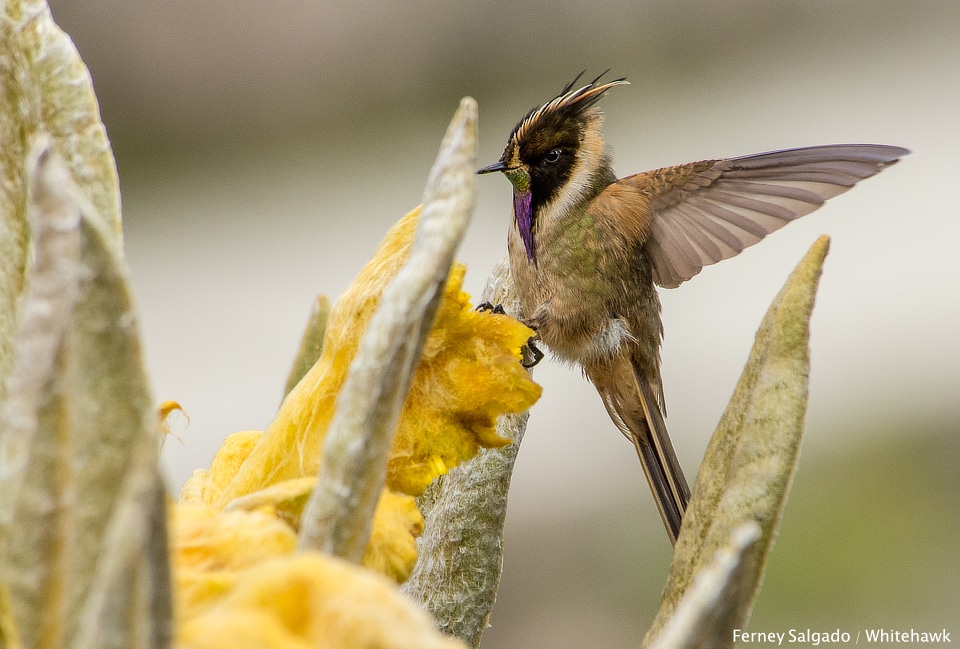
COLOMBIA: THREE ANDEAN MOUNTAIN RANGES
- Next tour dates July 2-18, 2025
- Duration 17 days
- Lodging 3 stars
- Difficulty Moderate
- Group size Max. 8 people
- Price USD $6,850 per person*
Overview
Colombia is considered a mega-diverse country, due, in part, to its awe-inspiring array of different habitats and ecosystems. This country is home to approximately one-fifth of the bird species on Earth. The Andean Mountain Range is one region that stands out for its incredible biodiversity, with richness in birds and high endemism. The Colombian Andes are divided into three mountain ranges, creating different conditions in each range and within the Inter-Andean Valleys. High-elevation paramo, humid montane forest, cloud forest and dry forest are just some of the ecosystems found in this region.
During our Colombia birding tour, we will explore these habitats from Cali to Bogota, as we search for the region’s incredibly beautiful and fascinating birds. This tour offers the possibility to see more than 25 endemic species. Brown-banded Antpitta, Cauca Guan, White-mantled Barbet and the flashy Multicolored Tanager are just a few we will encounter. Moreover, you will love the Colombian landscapes, rich culture and welcoming atmosphere.
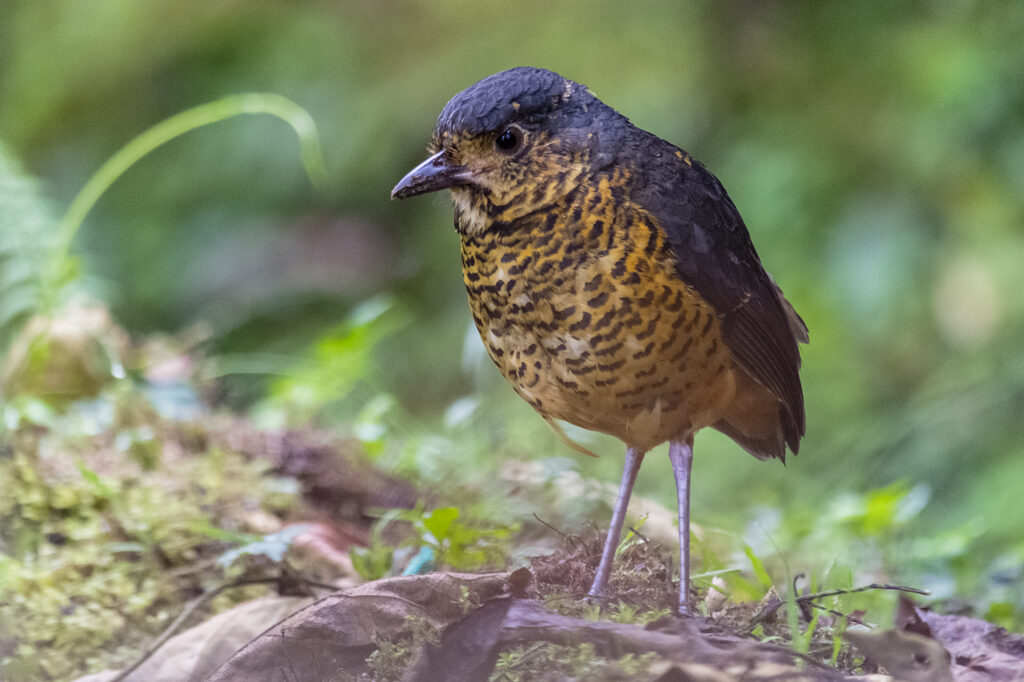
Itinerary
DAY 1: ARRIVAL IN CALI
Welcome to Colombia! We start off our Colombia birding tour at the Alfonso Bonilla Aragón International Airport in Cali. Cali is located in the Cauca Valley, a prime birding destination in Colombia. This afternoon, we will enjoy birding in the foothills west of Cali, there we will have the chance to see Colombian Chachalaca, Uniform Antshrike, Chestnut-fronted Macaw, Crested Quetzal and Golden-winged Manakin, among other birds.
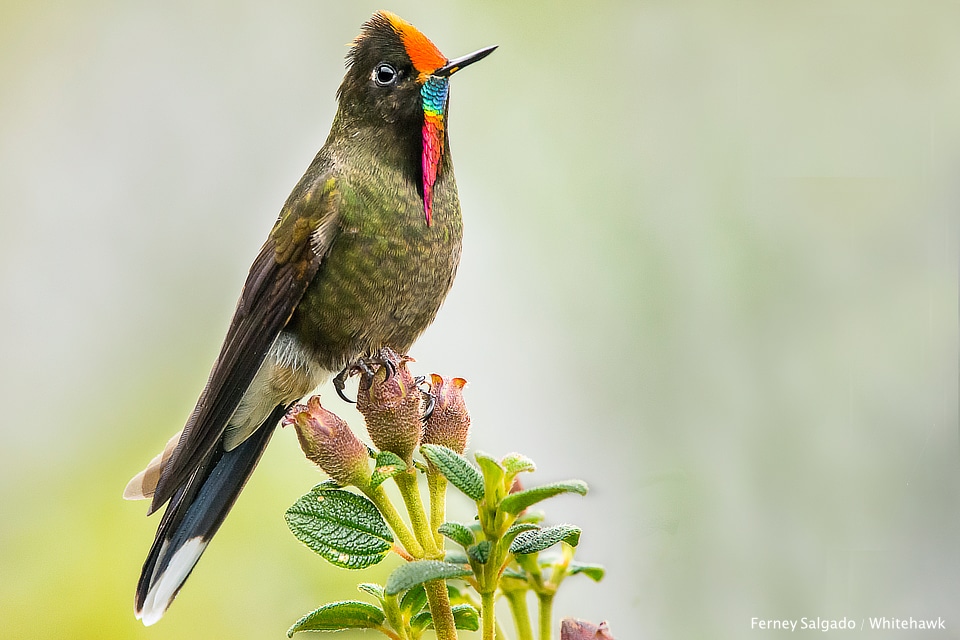
DAY 2: ANCHICAYA
At the Pacific slope of the western Andes, the Old Buenaventura Road crosses the forested area of Anchicaya at an elevation of 750 m. This area is influenced by the Choco region with a great chance to see some Choco specialties. While birding the forested roadsides, we will watch and listen for Choco Toucan, Zeledon’s Antbird, Golden-chested Tanager and Scarlet-browed Tanager.
DAY 3: KM-18 FINCA LA FLORIDA
One hour away from Cali on the eastern slope of the Western Andes, the San Antonio Forest sits at an altitude of 2,100 m. It is a great place to find nice Andean birds such as Scaled Fruiteater, Crested Quetzal and Sickle-winged Guan. We can also find other interesting birds in the feeders at Finca Alejandria. Here, it is possible to see the endemic Multicolored Tanager and several hummingbirds. Among them are the regional endemic Blue-headed Sapphire, Tourmaline Sunangel and Buff-tailed Coronet.
In the afternoon, we will drive to the Sonso Lagoon in Buga. A number of aquatic birds can be observed in this wetland. We hope to see Horned Screamer, White-faced Whistling-Duck, Masked Duck, Red-capped Cardinal and Yellow-hooded Blackbird. The vegetation around the lagoon is the perfect habitat for the endemic Apical Flycatcher. Little Cuckoo, Slate-headed Tody-Flycatcher and the regional endemic Spectacled Parrotlet are also birds we will search for today.
DAY 4: LAGUNA DE SONSO TO MONTEZUMA MOUNTAIN
We can revisit Laguna de Sonso this morning to pick up any targets we may still need, then we will work our way north to The Montezuma Mountains and Tatama National Park. The Montezuma Mountain has a strong Choco region influence, making it one of the most biologically diverse places on our Colombia birding tour. This combination between the Pacific and the Western Andes offers many national and regional endemics. We will travel approximately 4 hours to get there, birding along the way. Birding stops will give us the chance to find the endemic Turquoise Dacnis. In Montezuma, we will enjoy the hummingbird feeders. Violet-tailed Hummingbird, Empress Brilliant, Velvet-purple Coronet, White-tailed Hillstar and Purple-bibbed Whitetip can be seen here.
DAYS 5 & 6: TATAMA NATIONAL PARK
Two full days of birding in Montezuma. We will start very early, and drive all the way to the top of the mountain. While taking in the beautiful sunrise, we will start our day off with two endemic birds, the Chestnut-bellied Flowerpiercer and Munchique Wood-Wren. We will continue our way down the road in search of the endemics Gold-ringed Tanager, Black-and-gold Tanager and Golden-breasted Fruiteater.
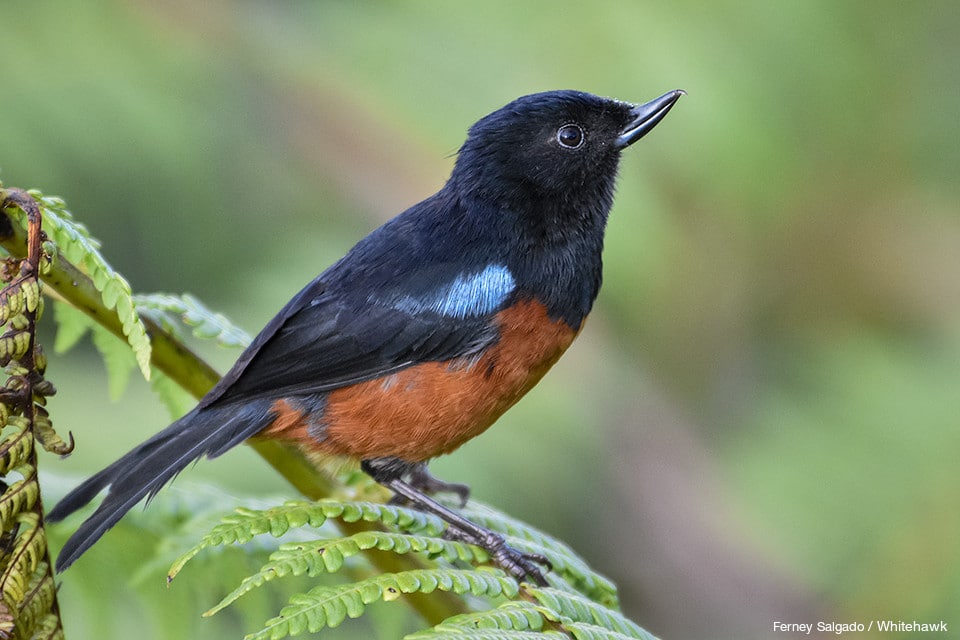
DAY 7: MONTEZUMA TO OTUN QUIMBAYA
A final morning along the Montezuma Road will give us a chance to seek out any other key species found here including Golden-headed Quetzal, Tatama Tapaculo, Toucan Barbet, Chestnut-breasted Chlorophonia, Powerful Woodpecker, Slate-crowned Antpitta, and Parker’s Antbird. We will then make our way back down the mountain and drive southeast to Otun Quimbaya Wildlife Sanctuary.
DAY 8: OTUN QUIMBAYA WILDLIFE SANCTUARY
After seven days in the Western Andes, we carry on into the central range. Otun Quimbaya is located at the foothill of the volcanic complex Ruiz-Tolima (Los Nevados National Park) at 1,900 m. This protected area is the best place to look for the Cauca Guan. This rare cracid is an endemic and endangered species, once believed to be extinct until this healthy population was recently rediscovered. Also, the largest Neotropical passerine, the Red-ruffed Fruitcrow, is found here with some ease. We will also look for the endemic Chestnut Wood-Quail and Stiles’s Tapaculo. Regional endemics such as Greenish Puffleg, Streak-capped Treehunter, Marble-faced Bristle-Tyrant, and Chestnut-breasted Wren, also will be highlights of our day.
DAY 9: RIO BLANCO RESERVE
The charm of this reserve lies in the possibility it offers to see several different species of antpittas up close. Here, Chestnut-crowned,Bicolored, Slate-crowned and the endemic Brown-banded antpittas are featured here. They are habituated to receive food from the local guide, luring them outside of the thick understory. At the productive feeders, it is possible to see White-bellied Woodstar, Wedge-billed Hummingbird, Fawn-breasted Brilliant, Buff-breasted Mountain-Tanager, and Slaty Brushfinch, among others. On the reserve’s trails, we will focus on searching for Black-billed Mountain-Toucan, Dusky Piha, Black-collared (Quindio) Jay, Golden-headed Quetzal and Masked Saltator, to name a few.
DAY 10: HACIENDA EL BOSQUE
Hacienda El Bosque is a dairy farm that has embraced nature tourism and birding. At and around the feeders, we will watch for Gray-breasted Mountain-Toucan, one of the stars of the reserve! Buff-breasted and Hooded mountain-tanagers, White-throated Quail-Dove, Barred Fruiteater, Gray-browed Brushfinch, and Red-crested Cotinga, are common here around the feeders and property. Purple-backed Thornbill, Shining Sunbeam, Tyrian Metaltail, Black-thighed Puffleg, Mountain Velvetbreast, and Buff-winged Starfrontlet frequent the nectar feeders. We can’t forget the antpittas – Equatorial, Bicolored, and Crescent-faced antpittas are found here.
In the afternoon, we will spend time at the Termales del Ruiz Hotel and its beautiful surroundings. At the hummingbird feeders, we hope to see Rainbow-bearded Thornbill, Sword-billed Hummingbird, Mountain Avocetbill, Black-thighed Puffleg, Shining Sunbeam, and Great Sapphirewing.
DAY 11: LOS NEVADOS NATIONAL PARK
With another early start this morning we will catch the first rays of the sun in the cloud and elfin forests along the way to Los Nevados National Park. Here we will look for the endemic Rufous-fronted Parakeet, as well as Andean Lapwing, Andean Teal, Golden-crowned Tanager, and Black-backed Bush Tanager. At the entrance of the national park at 4,100 m, we will look for the highlight of this region – the impressive Buffy Helmetcrest. This large, Andean hummer is endemic with a very restricted range. We can also find White-chinned Thistletail, Andean Tit-Spinetail, Stout-billed Cinclodes, Tawny Antpitta, Plain-capped Ground-Tyrant and Plumbeous Sierra-Finch. If we are very lucky, we may an Andean Condor soaring overhead. From here, we will travel along thePan-American Highway to Libano.
DAY 12: MIDDLE MAGDALENA VALLEY
The areas around Libano are great places to find three of the Tolima endemics – Yellow-headed Brushfinch, Tolima Blossomcrown, and the shy Tolima Dove, and we will concentrate our efforts today on seeking out these and other birds of the Middle Magdalena Valley. Velvety-fronted Euphonia, Barred Puffbird, White-eared Conebill, Northern White-fringed Antwren, and Russet-throated Puffbird are all possibilities, among many others. In the afternoon we will drive to Honda.
DAY 13: BELLAVISTA RESERVE
The Bellavista Reserve is situated in a lowland wet forest. It is a great place to see other Colombian endemics such as White-mantled Barbet, Antioquia Bristle-Tyrant, Sooty Ant-Tanager, Beautiful Woodpecker and Velvet-fronted Euphonia. We can also find Yellow-backed Tanager, Black-faced Dacnis and White-bibbed Manakin, among others.
DAY 14: GUARINOCITO LAKE
Today we will visit Guarinocito Lake, where we will have another opportunity to spot some aquatic birds that we have not yet seen. Here we scan the lake and its scrubby edge for Pied Water-Tyrant, White-headed Marsh-Tyrant, Yellow-chinned Spinetail and Black-capped Donacobius. However, the jewel of this lake is the Northern Screamer.
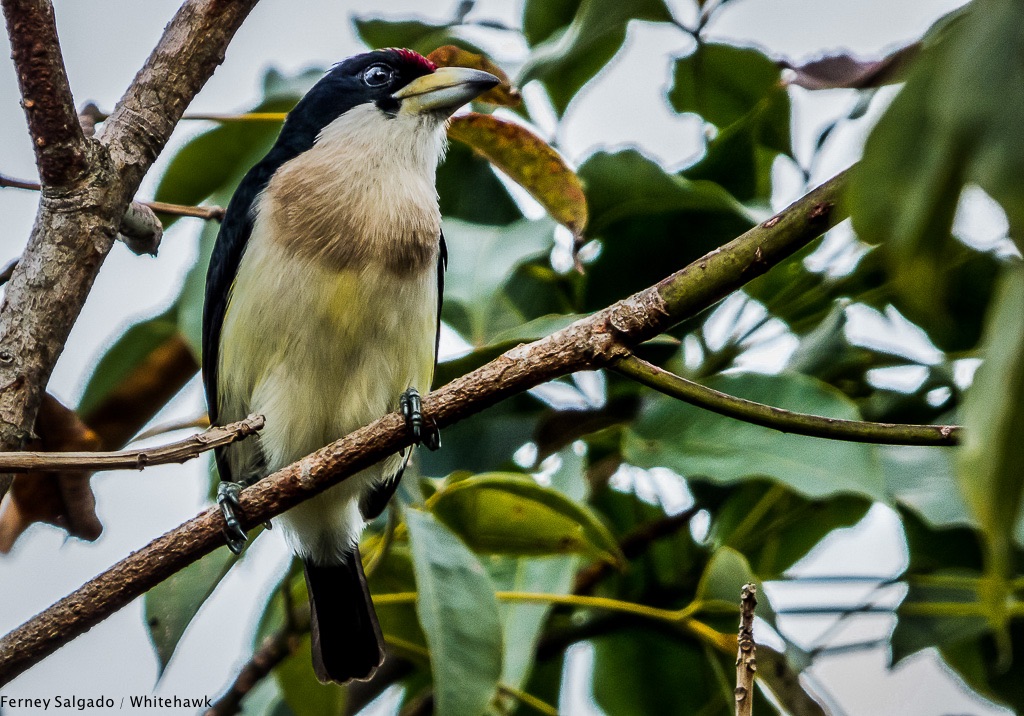
DAY 15: LAGUNA EL TABACAL & JARDIN ENCANTADO
As we continue to work our way east, a stop at Laguna el Tabacal will give us a chance to seek out some eastern Andean foothill species, including Rusty-breasted Antpitta, Black-headed Brushfinch, Gray-throated Warbler, and Stripe-breasted Spinetail, among others. On the way to Bogota, we will visit a farm with hummingbird feeders. Among its most prominent visitors is the endemic Indigo-capped Hummingbird. Other visitors we hope to see are the Shining-green Hummingbird, Gorgeted Woodstar, Red-billed and Short-tailed emeralds, Lazuline Sabrewing, and another fifteen hummingbird species. Around the farm, we also have the chance to find the Ash-browed Spinetail, Black-backed Grosbeak, and Gray-throated Warbler.
DAY 16: CHINGAZA NATIONAL PARK & HUMMINGBIRD OBSERVATORY
Chingaza National Park is renowned for its excellent birding opportunities. The park’s varying altitudes, overlooking Bogota, and habitats are home to a great diversity of birds, including endemics and rare species. Today we will look for birds unique to the eastern Andean highlands, including Muisca and Boyaca antpittas, Apolinar’s Wren, Rufous-browed Conebill, Bronze-tailed Thornbill, Green-bearded Helmetcrest, Brown-breasted Parakeet, along with other iconic Andean species such as Plushcap, Ocellated Tapaculo, and Black-chested Buzzard-Eagle. A visit to the “observatorio de colibries” will delight us with great views of Black-tailed and Green-tailed trainbearers, Blue-throated Starfrontlet, Longuemare’s Sunangel, and Coppery-bellied Puffleg, among others.
DAY 17: PARQUE LA FLORIDA & DEPARTURE
We will enjoy a final morning of birding at Parque La Florida, where we will hopefully have some luck finding the endemic Bogota Rail, as well as Andean Duck, Silvery-throated Spinetail, Spot-flanked Gallinule, Noble Snipe, Subtropical Doradito, Crimson-mantled Woodpecker, Black Flowerpiercer and many others. Then we will transfer to the airport and catch our return flights home.
Our Colombia birding tour concludes in Bogota.
Species
BIRDS
- Horned Screamer
- Northern Screamer
- White-faced Whistling-Duck
- Torrent Duck
- Andean Teal
- Colombian Chachalaca (E)
- Cauca Guan (E)
- Chestnut Wood-Quail (E)
- Striated Heron
- Andean Condor
- Snail Kite
- White-rumped Hawk
- Blackish Rail
- Tolima Dove (E)
- Cloud-forest Pygmy-Owl (re)
- Tourmaline Sunangel
- Tolima Blossomcrown (E)
- Violet-tailed Sylph
- Buffy Helmetcrest (E)
- Black-thighed Puffleg
- Buff-tailed Coronet (RE)
- Velvet-purple Coronet (RE)
- White-tailed Hillstar
- Purple-bibbed Whitetip
- Empress Brilliant
- Purple-throated Woodstar
- Gorgeted Woodstar
- Lazuline Sabrewing
- Red-billed Emerald (RE)
- Short-tailed Emerald (RE)
- Indigo-capped Hummingbird (E)
- Shining-green Hummingbird
- Blue-headed Sapphire
- Crested Quetzal
- Masked Trogon
- Moustached Puffbird
- White-mantled Barbet (E)
- Toucan Barbet
- Southern Emerald-Toucanet
- Black-billed Mountain-Toucan
- Choco Toucan
- Grayish Piculet (E)
- Beautiful Woodpecker (E)
- Crimson-mantled Woodpecker
- Yellow-eared Parrot (E)
- Rufous-fronted Parakeet (E)
- Bar-crested Antshrike (RE)
- Streak-headed Antbird
- Parker’s Antbird (E)
- Zeledon’s Antbird
- Chestnut-crowned Antpitta
- Bicolored Antpitta (RE)
- Chestnut-naped Antpitta
- Brown-banded Antpitta (E)
- Slate-crowned Antpitta
- Ocellated Tapaculo
- Stiles’s Tapaculo (E)
- Tatama Tapaculo (E)
- Ash-browed Spinetail (RE)
- Antioquia Bristle-Tyrant (E)
- Plain-capped Ground-Tyrant (RE)
- Apical Flycatcher (E)
- Orange-breasted Fruiteater
- Scaled Fruiteater
- Red-ruffed Fruitcrow
- Dusky Piha
- Golden-winged Manakin
- Club-winged Manakin
- Slaty-capped Shrike-Vireo
- Black-collared (Quindio) Jay
- Munchique Wood-Wren (E)
- Chestnut-breasted Wren
- Gray-throated Warbler
- Red-capped Cardinal
- Black-and-gold Tanager (E)
- Golden-chested Tanager
- Gold-ringed Tanager (E)
- Black-chinned Mountain-Tanager (RE)
- Purplish-mantled Tanager (RE)
- Multicolored Tanager (E)
- Scarlet-browed Tanager
- Turquoise Danis (E)
- Yellow-backed Tanager
- Chestnut-bellied Flowerpiercer (E)
- Yellow-headed Brushfinch
- Sooty Ant-Tanager (E)
- Crested Ant-Tanager (E)
- Red-bellied Grackle (E)
- Yellow-hooded Blackbird
- Velvet-fronted Euphonia (E)
TOUR BASICS
Guide: Edwin Campbell
Single Supplement: US$475
Lodging: Nice, clean and comfortable with private bath.
Food: Fresh, traditional cuisine.
Weather: Warm and humid in the valleys (lowlands) and temperate to cold in the highlands. Rain can be expected.
Difficulty: Moderate. Medium to long walks at a gentle pace, though some days will require longer walks on steep and/or muddy terrain. Some long drives and local air travel required.
*For more information on what is included/not included, as well as our booking and cancellation policies, please review our Terms & Conditions.
* With smaller groups, an additional fee will be charged.
LEARN MORE
Upcoming tour dates:
July 2-18, 2025
Past trip reports:
2019 Trip Report
From our blog:
Birds in Colombia: One-fifth of the world’s birds
The City of Antpittas
Colombia: New Tour, New Country, New Continent
